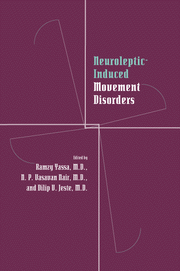Book contents
- Frontmatter
- Contents
- Contributors
- Preface
- Part I Historical perspective
- 1 Neuroleptic-induced movement disorders: historical perspective
- Part II Clinical aspects of tardive dyskinesia
- Part III Mechanisms underlying tardive dyskinesia
- Part IV Measurement of tardive dyskinesia
- Part V Tardive dyskinesia in different populations
- Part VI Other neuroleptic-induced movement disorders
- Part VII Treatment of tardive dyskinesia
- Index
1 - Neuroleptic-induced movement disorders: historical perspective
from Part I - Historical perspective
Published online by Cambridge University Press: 09 October 2009
- Frontmatter
- Contents
- Contributors
- Preface
- Part I Historical perspective
- 1 Neuroleptic-induced movement disorders: historical perspective
- Part II Clinical aspects of tardive dyskinesia
- Part III Mechanisms underlying tardive dyskinesia
- Part IV Measurement of tardive dyskinesia
- Part V Tardive dyskinesia in different populations
- Part VI Other neuroleptic-induced movement disorders
- Part VII Treatment of tardive dyskinesia
- Index
Summary
In February 1952, Laborit, Huguenard, and Alluaume published an article concerning the anesthetic properties of a new medication, chlorpromazine, mentioning therein the induction of a “psychic disinterest.” That same year, Delay, Deniker, and Harl (1952a,b), Delay et al. (1952c), and Hamon, Paraire, and Velluz (1952) first reported the effects of chlorpromazine in patients with various psychiatric conditions. A few months later, the effectiveness of the first neuroleptic was considered to have been demonstrated.
Initial Descriptions
The first description of an extrapyramidal syndrome during the course of neuroleptic treatment dates back to the 1953 Swiss symposium on chlorpromazine. The next year, Labhardt (1954) and Staehelin (1954) reported certain extrapyramidal complications caused by neuroleptics. It was Steck (1954, 1956), however, who vividly described such symptoms in a convincing manner. (Not until 1961 did Lambert and Broussolle note that it was not surprising that the Swiss authors had reported good results from their use of neuroleptics, given the high dosages used, which of course entailed a greater likelihood of developing extrapyramidal side effects.) Steck (1954) stated that “since the summer of 1953, we were impressed by the appearance of a well-developed parkinsonian syndrome in a chronic, cyclically agitated patient who also manifested schizophrenic symptomatology. This patient presented the well-known picture of post-encephalitic parkinsonism with psychomotor rigidity, tremors, facial seborrhea, marked salivation and akathisia.” Steck (1954) also reported the presence of extrapyramidal symptoms in 78 of 232 (34%) women and 33 of 77 (43%) men treated with neuroleptics.
- Type
- Chapter
- Information
- Neuroleptic-induced Movement DisordersA Comprehensive Survey, pp. 3 - 10Publisher: Cambridge University PressPrint publication year: 1996
- 1
- Cited by



